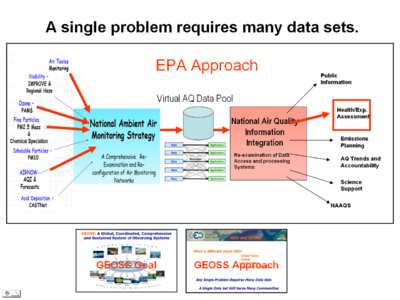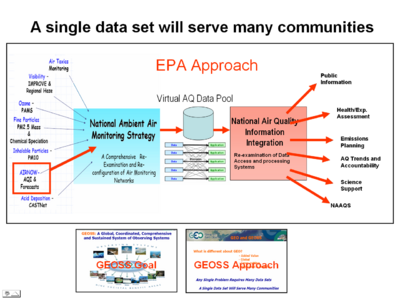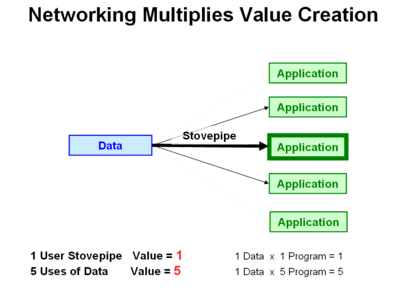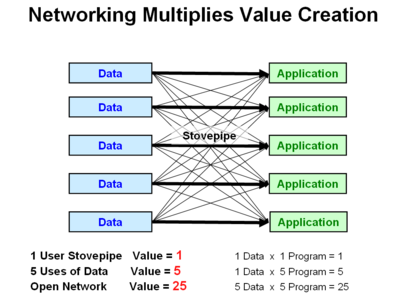Difference between revisions of "Networking of Air Quality Data"
| Line 61: | Line 61: | ||
In both of the above examples the estimation of the source strength requires the use of inverse modeling techniques in which the emission sources inferred from the measured concentration field and model-simulated transport characteristics. In fact, in case of natural smoke and dust events, such inverse modeling approach is the only known technique for estimating the source strength. The schematics of an observation-modeling system for biomass smoke estimation is shown in Figure ???. | In both of the above examples the estimation of the source strength requires the use of inverse modeling techniques in which the emission sources inferred from the measured concentration field and model-simulated transport characteristics. In fact, in case of natural smoke and dust events, such inverse modeling approach is the only known technique for estimating the source strength. The schematics of an observation-modeling system for biomass smoke estimation is shown in Figure ???. | ||
[[Image:TransferMatrix.png|500px]] | [[Image:TransferMatrix.png|500px]] | ||
| + | [[Image:Aerosol Characterizarion.png|500px]] | ||
| + | |||
[http://scholar.google.com/scholar?num=100&hl=en&lr=&q=AIRNow+Emission Google Scholar Search - AirNOW and Emission] | [http://scholar.google.com/scholar?num=100&hl=en&lr=&q=AIRNow+Emission Google Scholar Search - AirNOW and Emission] | ||
Revision as of 00:26, February 28, 2008
What links here: Networking of Air Quality Data
Related topics: DSS Architectures |
Background
The mission of the Environmental Protection Agency is to protect human health and the environment. Air quality management involves many activities including setting and maintaing air quality standards, monitoring trends, informing the public, etc. Each of these activities have different information needs. In the past both the monitoring and assessment of air quality has been performed in specific programs each directed and somewhat confined to the specific applications that they served.
Recently, the Agency developed and now is in the process of implementing a new National Air Monitoring Strategy(NAMS). NAMS was designed to produce more reusable datasets for multiple programs/applications in EPA. Implicit in the new strategy is that there is a corresponding new Information System strategy that facilitates the access, processing/analysis/integration of broad range of data applicable to multiple uses.
At the international level, the 70-nation Group on Earth Observations (or GEO) is coordinating international efforts to build a Global Earth Observation System of Systems (GEOSS). This emerging public infrastructure (system of systems) is interconnecting a diverse and growing array of instruments and systems for monitoring and forecasting changes in the global environment.
The common characteristics of both the planned EPA and GEOSS information systems are:
- A single problem requires many data sets.
- A single data set will serve many communities
The above two characteristics of the information system puts high demand on the architecture of the information system that facilitates the flow of the data resources from the providers to the users via a suitable data processing chain. An ingeneous solution to the many-to-many connections is illustrated schematically in the above "bow-tie" or fan in-fan out representation. The left hand side, fan in section, represents the collection of the distributed data resources into a common data access system, represented by the barrel. The potential users of the data, shown on the right hand side, satisfy their data by selecting from the common data pool. The fan out represents the fact that each user may need different combination of data and processing services.
It is recognized that creating a common database that collects all the relavent data and metadata into a single physical database is not practical. An alternative is the network approach where data and information services represent nodes in a network that can be dynamically connected to form user-driven data flow systems.
GEOSS, like the Internet, connects data/information providers and users; to deliver reliable, up-to-date and user friendly information – vital for the work of decision makers, planners and emergency managers. The GEOSS Approach is to build on existing systems, register and catalog reusable components provided voluntarily by the member organizations and to facilitate integration of these components through international standard interfaces.
Networking through the dynamic creation of loosely connected components has the potential to produce the well-known "Network Effect", where the value of the network increases in proportion to the number of network nodes squared. This non-linear behavior of producing overall value to the community is illustrated schematically below.
AirNow in an Network
Traditional air quality information systems provide end-to-end solutions through dedicated ‘Stovepipe’ processing streams However, many formerly closed data systems are now opening up and they share their data – through DataFed or other mediators In a federated approach data are homogenized and augmented with services and tools streams… The federated resources in turn can be fed back into individual project processing streams
The transition from the stovepipe to the networked, service oriented architecture can be gradual and non-disruptive.
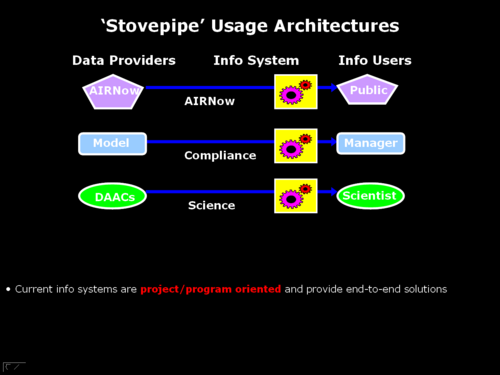
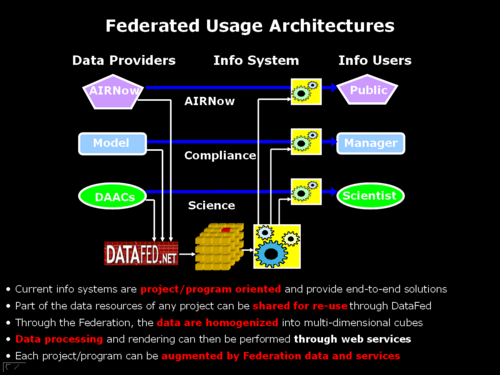
Example Application: AirNOW
AirNOW is a modern information system that collects and federates the monitoring data from hundreds of continuous air quality monitors operated autonomously by various agencies, mostly U.S. states. On the output side, the primary purpose of AirNOW is to deliver air quality status and forecast to the public. In-between is the AirNOW information systems that transforms the incoming raw data into usable, actionable knowledge. For more information, the reader is referred to the AirNOW and AirNOW Tech websites. A structured description of the AIRNow data system can be found on the AirNOW profile. A community workspace, the AIRNOW dataspace, facilitates the gathering of community contributed comments, resources, and feedback related to AirNOW.
The AIRNow program can deliver real-time ozone and PM2.5 concentration data to many different applications spanning several societal benefit areas including, health and ecological effect, disasters, and others. Conversely, fully informing the public can benefit from many data sets and analysises beyond those federated by the AirNOW system. For this reason, AirNOW represents an attractive application of the fan in - fan out networked information architecture adapted by GEOSS and by the EPA Air Quality Data Summit?
Public Information
Delineating the numerous pathways in which the AirNOW data are transmitted to the public is beyond the scope of this report.
Health/Exp. Assessment
In recent years the health effects of air pollutants in the U.S. are primarily attributed to surface ozone and fine particles. The AirNOW network provides monitoring data for these two pollutants. The companion network is the regulatory network which uses daily average filter samples, collected every third day to characterize the PM2.5 pattern. Health exposures during short-term fine particle peaks, lasting a few hours, and the exposure during the off days cannot be estimated from the regulatory PM2.5 FRM sampling network. In the past, epidemiological and event-based health studies had to rely on PM2.5 surrogates such as visibility data to associate health effect measures with the corresponding PM2.5 exposure.
For this reason the continuous measurements of PM2.5 allows better association of health and pollution signals. This in turn should permit the development of more suitable air quality standards for PM2.5. The continuous AirNOW monitoring data for ozone is compatible to the continuous ozone monitors in the regulatory ozone network.
Google Scholar Search - AirNOW and health
Emissions Estimation and Planning
An interesting application of the hourly AirNOW data pertains to improved estimation of emissions. The short time-resolution of the AIRNow monitors can charecterize the concentration variability, such as the diurnal cycle and concentration pulses. Many local sources such as automobile traffic have strong diurnal cycles driven by the traffic intensity and atmospheric dispersion characteristics. Comparing the diurnal cycle of neighboring sites with and without local source allows the estimation of the added local contribution.
In some cases, such as fires and dust events, the emission source causes a transient pulse at nearby receptor sites that may last only a few hours. In that case, comparison of mearby impacted and un-impacted sites provides a measure of the transient source strength.
In both of the above examples the estimation of the source strength requires the use of inverse modeling techniques in which the emission sources inferred from the measured concentration field and model-simulated transport characteristics. In fact, in case of natural smoke and dust events, such inverse modeling approach is the only known technique for estimating the source strength. The schematics of an observation-modeling system for biomass smoke estimation is shown in Figure ???.
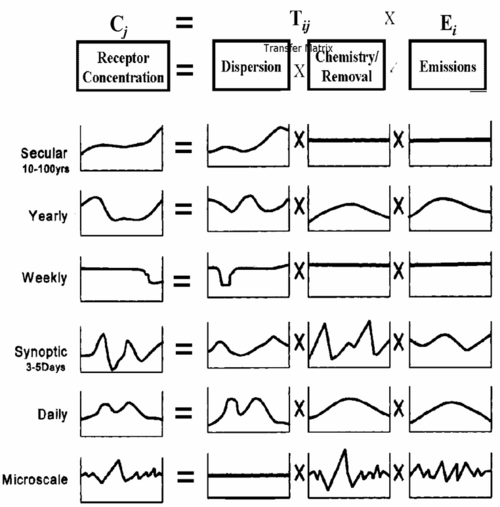
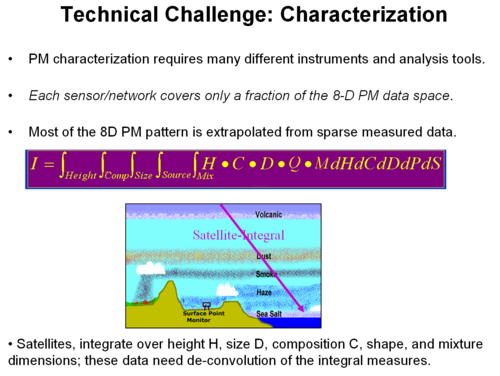
Google Scholar Search - AirNOW and Emission
AQ Trends and Accountability
Google Scholar Search - AirNOW and Trend
Intercontinental Transport Policy
Google Scholar Search - AirNOW and Intercontinental Transport
Pollutant Characterization
Science Support
Vertical Transport: Air quality monitoring with fine time resolution sensors can provide significant insights for the characterization of atmospheric processes such as vertical transport. Here again, the diurnal cycle of a given pollutant can reveal whether a substance is emitted from the ground, or is it transported downward from elevated pollutant layers. Elevated pollutant layers, such as those arising from long-range transport, tend to produce surface concentration pattern which peak during the daytime period when the mixing is strongest. At night, those layers are generally decoupled from the surface and dry deposition tends to deplete the concentration in the shallow nocturnal boundary layer. An example for such a case was documented during the April,1998 Asian dust event as it impacted the PM10 concentrations. Figure?? shows virtually identical diurnal pattern observed by a cluster of ten monitoring sites near Sacramento, CA. The high concentration plateau corresponds to the time when the daytime mixing caused the downwash of the elevated layer while the nighttime decay shows the role of dry deposition of dust in the nocturnal PBL.
Data Fusion: Characterization Data Fusion
NAAQS
Google Scholar - AIRNow and NAAQS
- Regulatory (Except Event)
- Regional Haze Rule (RPO)
NASA Applications of Air Quality Data
NOAA Applications of Air Quality Data
Model Eveluation (Assimilations/Verification)
